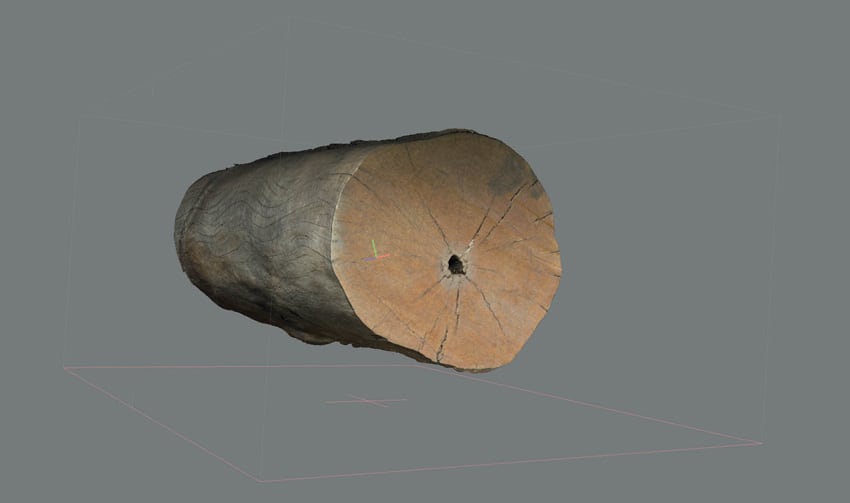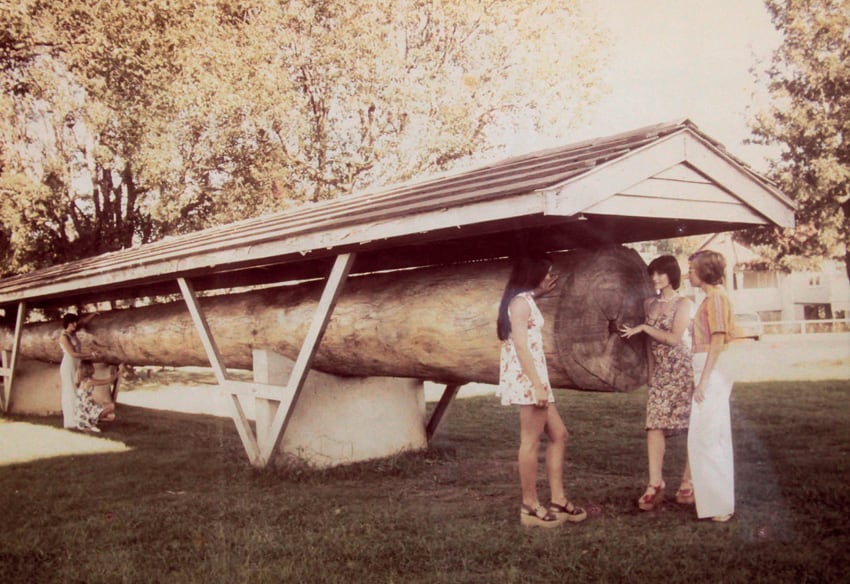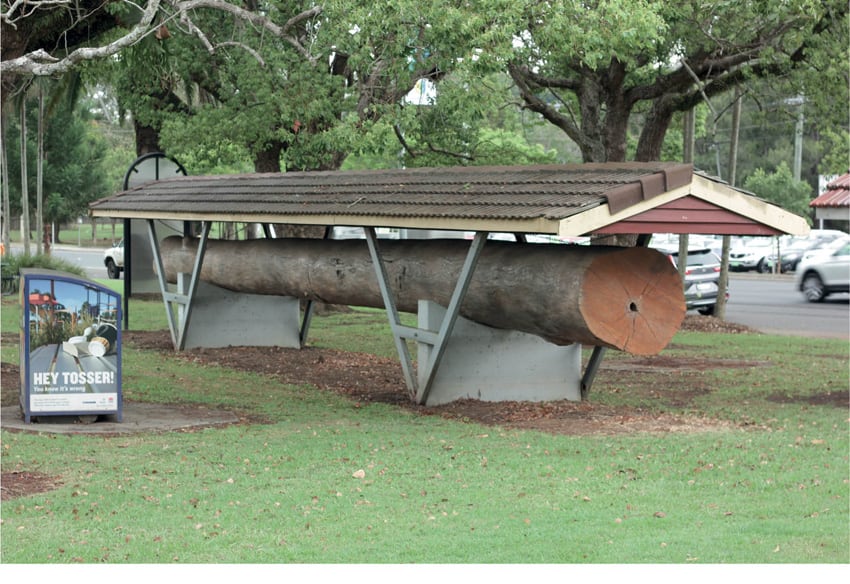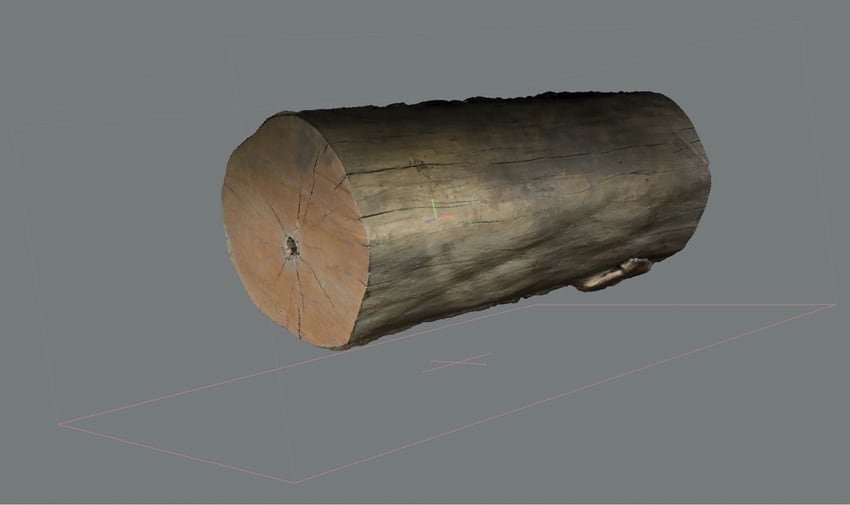Beginning in March 2016, I undertook a two-year period of practice-led research as part of a Master of Fine Arts (MFA) research degree at Sydney College of the Arts. The origin of the research project lay in a self-reflexive inquiry into my attraction to working with steel and other metals in my art practice. Through a study of a history of making within my family, I wound up six generations back, investigating the cultural and environmental impacts of my ancestors’ colonisation of Bundjalung Country.
The research centres on the northern New South Wales city of Lismore, which is situated within a region of the Bundjalung Nation referred to as the ‘Northern Rivers’. Lismore sits on the Wilsons River, itself an arm of the Richmond River, and the flow of water in this Country has long enabled the movement of bodies and materials, human and non-human.
My great-great-great-grandparents George John Cooper and Jane Sarah Cooper (née Miller), and their young son, also named George, together with a group of other families sailed up the eastern coast of Australia and along the Richmond River on board two boats, the Little Sally and the Northumberland.1 Arriving in the late 1830s, these families were among the first non-Indigenous people to intrude upon this Country in search of the highly prized timber species, red cedar (Toona ciliata).2 Following this same route in reverse, the felled logs were transported to Sydney where the timber was used for joinery, furniture and cabinetmaking, serving a vital role in the economic development of the colony of New South Wales.3
The Country that my forbears initially encountered is today drastically altered. The area stretching east from Lismore almost all the way to the Pacific coast near Byron Bay was once Australia’s largest tall tree, lowland subtropical rain forest,4 covering an estimated 75,000 hectares.5 The name given to this area by the mostly English, Scottish and Irish settlers was ‘The Big Scrub’,6 while to Widjabal/Wiy-abal people it is known as Woorbeh.7 Red cedar once grew in abundance along most of Australia’s east coast, but was logged to the point of ‘economic extinction’ by the early twentieth century.8 Within The Big Scrub/Woorbeh, cedar-getters didn’t undertake large-scale land clearing themselves, but rather they picked out red cedar and other valuable tree species one by one.9 In doing so, they contributed to irreversible environmental and cultural damage, and opened up territory that other settlers and selectors would occupy. This would lead to the rapid clearing of most of the rainforest in the area, which was encouraged by the Robertson Land Acts of 1861.10 By 1900, it is estimated that a little more than one percent of this rainforest remained.11
As the name given to the region surrounding Lismore suggests, water is normally abundant in this Country. Heavy rainfall often swells the area’s many creeks and tributaries; flooding is common and sometimes severe. The ramifications of my ancestors’ actions are still present in the floodwaters that inundate the city. Because the rainforest around Lismore was cleared to the edge of the rivers and creeks, their banks eroded.12 Streams that were once clear to their bottom became a silty, opaque brown.13 Siltation has had the effect of reducing the rivers’ holding capacity, and the draining of wetlands has left nowhere for runoff, so that by the end of the nineteenth century flooding in Lismore had intensified.^14 The actions of my ancestors irrevocably changed this Country, and there is a tributary flowing into the Wilsons River at Boatharbour named Coopers Creek that memorialises this impact. The imposition of this name on Widjabal/Wiy-abal Country was a significant step in the process of colonisation, tied to the concept of terra nullius, and embodying the ‘existential necessity the traveller feels to invent a place he can inhabit.’15
What connects this study of the past to my present is the imperative to confront my ‘[s]ettler’s inheritance’.16 To me this means: to track the ecological and cultural impacts caused by this occupation, to explore responsive strategies for living on this Country, and to assess the potential of art-making as a framework through which I aim to contribute to an ongoing process of reconciliation between non-Indigenous Australians and Aboriginal and Torres Strait Islander people.
One way I have set out to do this is to form a sustained engagement with Aboriginal people from Lismore, as well as seeking their permission to conduct research into the histories of red cedar, its logging and its present condition within the Lismore area. In order to do this, the individuals that I have interacted with have had to find time to accommodate me, and I have been reliant on their generosity. In obtaining Human Research Ethics approval from the University of Sydney in October 2016 to conduct oral history interviews for my Master of Fine Arts (MFA), I developed a research methodology and research agreement with the then Chief Executive Officer (CEO) of Ngulingah Local Aboriginal Land Council (LALC), Mikael Smith. This land council is the statutory body representing the traditional custodians of the Country that the research project focuses on.
The outcomes of my research project represent the initial stages of a complex process of adaptation and transformation, both within my art practice and my life. As a male, settler-descendant I am in a privileged position within the art world, and also within Australian society at large, but this process is not simply a matter of giving up this privilege.17 The challenge is figuring out what I can do to reshape my life, and the incremental adjustments resulting from this thought process are evident in the changing nature of my art-making.
The close study of material displacements affected by my ancestors, and the ensuing cultural and environmental consequences, has forced me to re-appraise the way I work with materials. For example, my pre-existing relationship with the materials that form the basis of galvanised steel sculptures that I have made has been troubled. This re-evaluation stems from questioning the provenance of the iron ore and zinc that comprise the raw materials in this process,18 and confronting the socio-cultural and ecological consequences of these particular types of resource extraction.19
I spoke with one Widjabal/Yaegl man from Lismore in August 2017. While he wished to remain anonymous, permitting me to take notes, he recalled how he’d learnt about cedar-getters in school as celebrated pioneers, and he laughed as he told me the punning nickname he used for them: ‘seehowtheygotus.’20 The tragedy underlying this humorous play on words was exposed when he went on to explain how his ancestors had led European timber-getters to stands of red cedar, only to be killed once they had provided this information.21 I asked him about how red cedar trees figure in community life now, and he replied half-jokingly, ‘Where are they?’ as he motioned with his arm, indicating their scarcity.^22
While thinking about this encounter and conducting further research into red cedar, I came across a news story involving a prominent Bundjalung artist from Lismore, Digby Moran, and a mature red cedar specimen located in the centre of Lismore. This tree was displaced from its original location at Brindle Creek, part of what is now the Border Ranges National Park, in the late 1960s.^23 It has been laid on its side to rest under a pitched roof in a small park located behind Lismore’s City Hall as a memorial to the cedar cutters of the Richmond River, its decay arrested through surface treatment and a purpose-built shelter. As part of planned upgrades to the City Hall building and surrounds in 2013, it was proposed that the cedar log be moved to a more prominent location and that a motif of Digby’s would be carved into part of it.24
The idea behind the proposal was to create a public artwork that could both commemorate the pioneering spirit of the cedar-getters who helped to transform this Country, and to celebrate the enduring artistic and cultural practices of Bundjalung people; to ‘combine and preserve both cultures.’25 The carving was to evoke the dendroglyphs that were carved by Bundjalung people and which were once common in the Lismore area.26 Concerns about the proposal were raised by members of the Richmond River Historical Society because, according to them, Aboriginal carvings were traditionally applied to hardwood species of timber, and red cedar is a softwood.^27
After these issues about the historical accuracy of a Bundjalung artist carving into red cedar were presented, the ‘mixing [of] histories’ potentially causing ‘conflict and misinformation’ in the Lismore community,^28 the plans were changed, and the log was left in situ without Digby’s carvings. While this approach to historical accuracy may have altruistic intentions, unfortunately it reinforces a mode of engaging with the past that views Bundjalung cultural practices as something static. Lynette Russell refers to this chronological flattening of Aboriginal cultural practices by historians and archaeologists as the ‘homogeneity paradigm’.29 The objections to the proposal suggest the tensions inherent in the way the public art project was framed; as an attempt to ‘combine’ two cultures, rather than as an acknowledgment of difference.
While a great deal of traditional knowledge has been lost because of invasion and colonisation, Bundjalung culture is alive and contemporary cultural knowledge is evolving.30 With this thought in mind I sought permission from Digby to begin a process of artistic engagement with the cedar log memorial that had the potential to result in a collaboration between us. A quick Internet search of his name brought up his Facebook page, containing the statement, ‘if the big roller door is open then I’m there, please call in and say G’day anytime.’31

In October 2017, I visited Digby at his studio, where he made time for me while preparing the background of a new, large painting. Access is through a green roller door at street level; it’s a spacious, open room with a second, smaller room adjoining it. Digby showed me the back room where he is storing the many paintings of his that were irreparably damaged during the March flood,32 the timber stretchers warped and the backs of the canvases mouldy. Back in the main part of the studio, he pointed out a steel joist supporting the upper floor of the building. Approximately three metres from the ground, three pots of paint were stacked neatly in a line on the flange of the joist, in descending order of height. Close by, a corked glass bottle sat upside down on the ceiling, wedged at its base between a fluorescent light and the studio wall. These incongruously placed studio objects were the residual artefacts of the floodwaters that had drowned Digby’s studio, and had remained where the water had left them once it receded.
Because the red cedar log cannot be physically incised or altered, I had begun thinking about how I could facilitate Digby’s interaction with the log in a virtual space. During my visit to his studio, I brought up the possibility of using a technique known as photogrammetry to create a three-dimensional render of the log, on to which his design could be digitally ‘carved’. I am aware of the fact that I am the one who has instigated this proposed collaboration, rather than Digby approaching me, and I would not have proceeded if Digby was not interested, or without gaining his approval to do so.
Digby expressed his interest in seeing his designs worked into the cedar log in a digital environment and permitted me to begin photographing the log in order to obtain the images required for the photogrammetry process. Over the following months I worked on rendering a section of the tree that I could show to him to gauge his interest about working together further. I again travelled to Lismore in late January, 2018, and visited Digby in his studio a few days after Invasion Day. I showed him the 3D render I had been working on, and we decided to continue developing the work together.
Throughout this process, I have been prepared for the possibility that the work might not proceed past the concept stage, because, as Deborah Bird Rose comments in relation to ethical dialogue, ‘the concept of openness … is risky because one does not know the outcome.’33 And collaboration is unpredictable. Within this work-in-progress, the contested cedar log memorial can be viewed as a metaphor for the greater loss which occurred and is still being experienced on this Country. I acknowledge that I cannot restore what has been destroyed, and that due to abiding power relations in this Country, this collaboration is not an equal partnership. But, I can harness my privilege and skill set, and collaborate on a project with Digby that I hope will provide beneficial outcomes to him, and result in the creation of an artwork with ‘memorable form’.34
Kenzee Patterson spent his first twenty years living on Darug Country in Blacktown, a suburb of western Sydney. So far, this is the longest he has lived in any one location.
p. 19.



